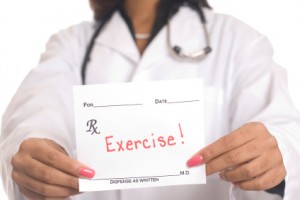 Many social indicators fail to measure what people think and feel about their lives—the quality of their relationships, their positive emotions, resilience, satisfaction with life domains, or the realization of their potential. Positive evaluations of life including the presence of positive emotions (e.g., happiness, serenity, interest), social ties, and perceptions of life satisfaction and meaning, are commonly referred to as “well-being”.
Many social indicators fail to measure what people think and feel about their lives—the quality of their relationships, their positive emotions, resilience, satisfaction with life domains, or the realization of their potential. Positive evaluations of life including the presence of positive emotions (e.g., happiness, serenity, interest), social ties, and perceptions of life satisfaction and meaning, are commonly referred to as “well-being”.
Category: Health
Why is it important for people with diabetes to be physically active?
 Physical activity can help you control your blood glucose, weight, and blood pressure, as well as raise your “good” cholesterol and lower your “bad” cholesterol. It can also help prevent heart and blood flow problems, reducing your risk of heart disease and nerve damage, which are often problems for people with diabetes.
Physical activity can help you control your blood glucose, weight, and blood pressure, as well as raise your “good” cholesterol and lower your “bad” cholesterol. It can also help prevent heart and blood flow problems, reducing your risk of heart disease and nerve damage, which are often problems for people with diabetes.
Chronic Conditions and Aging
 Arthritis and hypertension are the two most common health conditions affecting older workers, impacting 47% and 44%, respectively, of workers over the age of 55. An even greater proportion of workers (more than 75%) are estimated to have at least one chronic health condition that requires management. Diabetes is perhaps the most costly of these; one study found that 1/3 of all Medicare spending goes towards management of diabetes. The frequency of these conditions and others in older adults has important implications for workers can physically perform their duties, but also when. Higher morbidity means more absenteeism when an employee feels sick and more presenteeism when an employee is ill but shows up to work regardless. However, individual health risk factors are a stronger influence on future healthcare associated costs than advancing age alone. In comparing young workers with “high risk” of chronic disease (5 or more risk factors) to older workers with few or no risk factors, the younger workers had significantly higher medical costs associated despite the disparity in the age groups: 19-34 year olds, versus older workers aged 65-74.
Arthritis and hypertension are the two most common health conditions affecting older workers, impacting 47% and 44%, respectively, of workers over the age of 55. An even greater proportion of workers (more than 75%) are estimated to have at least one chronic health condition that requires management. Diabetes is perhaps the most costly of these; one study found that 1/3 of all Medicare spending goes towards management of diabetes. The frequency of these conditions and others in older adults has important implications for workers can physically perform their duties, but also when. Higher morbidity means more absenteeism when an employee feels sick and more presenteeism when an employee is ill but shows up to work regardless. However, individual health risk factors are a stronger influence on future healthcare associated costs than advancing age alone. In comparing young workers with “high risk” of chronic disease (5 or more risk factors) to older workers with few or no risk factors, the younger workers had significantly higher medical costs associated despite the disparity in the age groups: 19-34 year olds, versus older workers aged 65-74.
via CDC – Healthy Aging – NIOSH Workplace Safety and Health Topic.
What Is Mental Health?
 Mental health includes our emotional, psychological, and social well-being. It affects how we think, feel, and act. It also helps determine how we handle stress, relate to others, and make choices. Mental health is important at every stage of life, from childhood and adolescence through adulthood.
Mental health includes our emotional, psychological, and social well-being. It affects how we think, feel, and act. It also helps determine how we handle stress, relate to others, and make choices. Mental health is important at every stage of life, from childhood and adolescence through adulthood.
Over the course of your life, if you experience mental health problems, your thinking, mood, and behavior could be affected. Many factors contribute to mental health problems, including:
- Biological factors, such as genes or brain chemistry
- Life experiences, such as trauma or abuse
- Family history of mental health problems
Mental health problems are common but help is available. People with mental health problems can get better and many recover completely.
Early Warning Signs
Not sure if you or someone you know is living with mental health problems? Experiencing one or more of the following feelings or behaviors can be an early warning sign of a problem:
- Eating or sleeping too much or too little
- Pulling away from people and usual activities
- Having low or no energy
- Feeling numb or like nothing matters
- Having unexplained aches and pains
- Feeling helpless or hopeless
- Smoking, drinking, or using drugs more than usual
- Feeling unusually confused, forgetful, on edge, angry, upset, worried, or scared
- Yelling or fighting with family and friends
- Experiencing severe mood swings that cause problems in relationships
- Having persistent thoughts and memories you can’t get out of your head
- Hearing voices or believing things that are not true
- Thinking of harming yourself or others
- Inability to perform daily tasks like taking care of your kids or getting to work or school
Allergies
 Allergies are among the most common chronic conditions worldwide. Allergy symptoms of allergies range from making you miserable to putting you at risk for life-threatening reactions.
Allergies are among the most common chronic conditions worldwide. Allergy symptoms of allergies range from making you miserable to putting you at risk for life-threatening reactions.
According to the leading experts in allergy, an allergic reaction begins in the immune system. Our immune system protects us from invading organisms that can cause illness. If you have an allergy, your immune system mistakes an otherwise harmless substance as an invader. This substance is called an allergen. The immune system overreacts to the allergen by producing Immunoglobulin E (IgE) antibodies. These antibodies travel to cells that release histamine and other chemicals, causing an allergic reaction.
Allergy Symptoms
An allergic reaction typically triggers symptoms in the nose, lungs, throat, sinuses, ears, lining of the stomach or on the skin. For some people, allergies can also trigger symptoms of asthma. In the most serious cases, a life-threatening reaction called anaphylaxis (an-a-fi-LAK-sis) can occur.
A number of different allergens are responsible for allergic reactions. The most common include:
• Pollen
• Dust
• Food
• Insect stings
• Animal dander
• Mold
• Medications
• Latex
via Allergies | AAAAI.
Quick tips to a healthier back
 Following any period of prolonged inactivity, begin a program of regular low-impact exercises. Speed walking, swimming, or stationary bike riding 30 minutes a day can increase muscle strength and flexibility. Yoga can also help stretch and strengthen muscles and improve posture. Ask your physician or orthopedist for a list of low-impact exercises appropriate for your age and designed to strengthen lower back and abdominal muscles.
Following any period of prolonged inactivity, begin a program of regular low-impact exercises. Speed walking, swimming, or stationary bike riding 30 minutes a day can increase muscle strength and flexibility. Yoga can also help stretch and strengthen muscles and improve posture. Ask your physician or orthopedist for a list of low-impact exercises appropriate for your age and designed to strengthen lower back and abdominal muscles.
- Always stretch before exercise or other strenuous physical activity.
- Don’t slouch when standing or sitting. When standing, keep your weight balanced on your feet. Your back supports weight most easily when curvature is reduced.
- At home or work, make sure your work surface is at a comfortable height for you.
- Sit in a chair with good lumbar support and proper position and height for the task. Keep your shoulders back. Switch sitting positions often and periodically walk around the office or gently stretch muscles to relieve tension. A pillow or rolled-up towel placed behind the small of your back can provide some lumbar support. If you must sit for a long period of time, rest your feet on a low stool or a stack of books.
- Wear comfortable, low-heeled shoes.
- Sleep on your side to reduce any curve in your spine. Always sleep on a firm surface.
- Ask for help when transferring an ill or injured family member from a reclining to a sitting position or when moving the patient from a chair to a bed.
- Don’t try to lift objects too heavy for you. Lift with your knees, pull in your stomach muscles, and keep your head down and in line with your straight back. Keep the object close to your body. Do not twist when lifting.
- Maintain proper nutrition and diet to reduce and prevent excessive weight, especially weight around the waistline that taxes lower back muscles. A diet with sufficient daily intake of calcium, phosphorus, and vitamin D helps to promote new bone growth.
- If you smoke, quit. Smoking reduces blood flow to the lower spine and causes the spinal discs to degenerate.
via Low Back Pain Fact Sheet: National Institute of Neurological Disorders and Stroke (NINDS).
Eat Well, Exercise, Moderate Alcohol Intake, Don’t Smoke, And Live Longer
 Following four healthy behaviors was associated with a lower risk of death in this analysis of data from 16,958 people who took part in the National Health and Nutrition Examination Survey III Mortality Study. Researchers collected information on lifestyle behaviors from the participants between 1988 and 1994 and followed the group until 2006 to determine who died. Each healthy behavior was associated with a significant reduction in the risk of death during the study follow up, but people who had all four healthy behaviors had some dramatic reductions in their risk of death. People who ate a healthy diet, got enough exercise, drank moderate amounts of alcohol, and did not smoke had a 63% lower risk of all-cause death, 66% lower risk of death from cancer, 65% lower risk of death from cardiovascular disease, and 57% lower risk of death from all other causes during follow-up compared to people who did not have any of these healthy behaviors. While many people had at least one healthy behavior, only 4.8% of the participants had all four.
Following four healthy behaviors was associated with a lower risk of death in this analysis of data from 16,958 people who took part in the National Health and Nutrition Examination Survey III Mortality Study. Researchers collected information on lifestyle behaviors from the participants between 1988 and 1994 and followed the group until 2006 to determine who died. Each healthy behavior was associated with a significant reduction in the risk of death during the study follow up, but people who had all four healthy behaviors had some dramatic reductions in their risk of death. People who ate a healthy diet, got enough exercise, drank moderate amounts of alcohol, and did not smoke had a 63% lower risk of all-cause death, 66% lower risk of death from cancer, 65% lower risk of death from cardiovascular disease, and 57% lower risk of death from all other causes during follow-up compared to people who did not have any of these healthy behaviors. While many people had at least one healthy behavior, only 4.8% of the participants had all four.
via Eat Well, Exercise, Moderate Alcohol Intake, Don’t Smoke, And Live Longer | Rodale News.
How Can I Protect Skin From the Sun?
 Nothing can completely undo sun damage, although the skin can sometimes repair itself. So, it’s never too late to begin protecting yourself from the sun. Follow these tips to help prevent sun-related skin problems:
Nothing can completely undo sun damage, although the skin can sometimes repair itself. So, it’s never too late to begin protecting yourself from the sun. Follow these tips to help prevent sun-related skin problems:
- Apply sunscreen with a sun protection factor (SPF) of 30 or greater at least 30 minutes before sun exposure and then at least every 2 hours thereafter, more if you are sweating or swimming
- Select cosmetic products and contact lenses that offer UV protection
- Wear sunglasses with total UV protection
- Wear wide-brimmed hats, long sleeved shirts, and pants
- Avoid direct sun exposure as much as possible during peak UV radiation hours between 10 a.m. and 2 p.m.
- Perform skin self-exams regularly to become familiar with existing growths and to notice any changes or new growths
- Eighty percent of a person’s lifetime sun exposure is acquired before age 18. As a parent, be a good role model and foster skin cancer prevention habits in your child
- Avoid tanning beds
via Sun Safety Tips.
5 Easy Steps to Living Long and Well
 Living past 90, and living well, may be more than a matter of good genes and good luck. Five behaviors in elderly men are associated not only with living into extreme old age, a new study has found, but also with good health and independent functioning.
Living past 90, and living well, may be more than a matter of good genes and good luck. Five behaviors in elderly men are associated not only with living into extreme old age, a new study has found, but also with good health and independent functioning.
The behaviors are abstaining from smoking, weight management, blood pressure control, regular exercise and avoiding diabetes. The study reports that all are significantly correlated with healthy survival after 90.
via Gentlemen, 5 Easy Steps to Living Long and Well – New York Times.
Meditation: A Simple, Fast Way to Reduce Stress
 If stress has you anxious, tense and worried, consider trying meditation. Spending even a few minutes in meditation can restore your calm and inner peace.
If stress has you anxious, tense and worried, consider trying meditation. Spending even a few minutes in meditation can restore your calm and inner peace.
Anyone can practice meditation. It’s simple and inexpensive, and it doesn’t require any special equipment.
And you can practice meditation wherever you are — whether you’re out for a walk, riding the bus, waiting at the doctor’s office or even in the middle of a difficult business meeting.
via Meditation: Take a stress-reduction break wherever you are – Mayo Clinic.
